|
< Earlier Kibitzing · PAGE 23 OF 24 ·
Later Kibitzing> |
Aug-27-15
 | | keypusher: <HeMateMe: The medieval battle of Againcourt:
<http://en.wikipedia.org/wiki/Battle... I wonder why this opening is named "Againcourt"?> Presumably it is named <Agincourt> because Black meets the English Opening with a French Defense set-up. < Could it be for the long line of pawns facing each other, mirroring battle tactics of the Hundred Years War?> That sounds more like World War I to me. The illustration at your wikipedia link, with archers blazing away at each other from about 10 feet, doesn't bear much resemblance to the actual battle. Interesting description of the fighting in wikipedia. Hard to believe that the French, with a huge numerical advantage, would choose a narrow battlefield where they could not bring most of their soldiers into action. Years ago I read John Keegan's account in <The Face of Battle> -- worth your time, but I can't remember what he said about this. I don't like the opening name, I have to say. Agincourt was a legendary English victory, so to apply it to this opening battle between the English Opening and the French Defense sort of prejudges the merits, I think. Also, the French didn't defend at Agincourt: they attacked. Maybe "Agincourt Defense" refers to Henry's clever defensive setup at the start of the battle, but then the names of the openings are backwards. I'm probably overthinking this. |
|
Aug-27-15
 | | keypusher: Overthinking this some more, when Black plays ...e6 and ...d5 against the English, he's not playing the French Defense, obviously. He's saying <a fig for your fancy flank strategy. Either play the Queen's Gambit (as in Fischer vs Spassky, 1972) or concede me an equal or superior share of the center> (as in this game). So, yeah. Not a great opening name. To quote Botvinnik, <brilliant, but that's all!> (about White's tenth move in the game below). Tolush vs Botvinnik, 1939 |
|
| Jan-25-18 | | tgyuid: for me, 45...Nxf3 is the story of this tournament; the point at which romantic uncertainties resolve as demonstrable mathematics |
|
| Jan-25-18 | | tgyuid: furthermore i think euwe would be quite proud tthat his generation was superseded by the kind of quality only professionalism may posess |
|
Aug-11-21
 | | KEG: A very difficult game in which Keres tried an unusual opening, got the inferior game, walked into a dangerous pin with 25. a4, and then blundered with 27. Nc1? which allowed Botvinnik to achieve and maintain a winning bind and eventually win material. Keres thereafter set several traps, but Botvinnik was not to be distracted. At the time this game was played, Botvinnik, Keres, and Reshevsky were vying for the lead (the latter having blundered away a winning position against Botvinnik in the prior round. Botvinnik was a half-point ahead of Keres when the game--played in the final round of the first (of five) laps--allowed Botvinnik to pull into the lead by a full point. Botvinnik never lost this lead for the balance of the tournament. The loss here by Keres is often cited as evidence for his supposed throwing games in this tournament to Botvinnik so the latter could win the title. While not denying several troubling circumstances, I find the evidence less than completely convincing. The fact that Botvinnik scored 4 out of 5 against Keres in this tournament is not inconsistent with their prior record (Botvinnik had won two and drawn his other six games against Keres prior to this tournament). On form, I would have expected Botvinnik toe score approximately 3 points out of a possible five, so the result here was not a complete shock. The score in this game also does not support a charge of Keres throwing games to Botvinnik, despite Golombek's claim that Keres' play here was "inexplicably weak throughout this game" and that had he not known otherwise he would "hardly have believed that Keres was the conductor of the white pieces." In fact, this was a difficult game for both players, and many of Keres' errors occurred in severe time pressure. Some of the allegedly weak moves by Keres were in fact not so bad. Keres' heroic efforts to save a lost position also does not fit the pattern. I am more troubled by Keres' play in the next two games against Botvinnik, but I will treat those games in dur course. I am also troubled that Keres' one win against Botvinnik in this tournament came in the final round after Botvinnik had clinched first place and Smyslov had clinched second. This win by Keres allowed him to tie Reshevsky for 3rd/4th. But for now, let's examine the game at hand.
1. c4 e6
2. g3

click for larger viewKeres played this line (which had been a favorite of Blackburne decades earlier) only one other time in his career. Given his poor results against Botvinnik in the past, his decision to try something different makes sense. 2... d5
3. Bg2 d4
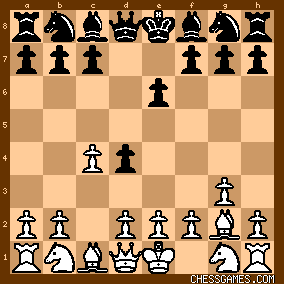
click for larger view"!"--(Horowitz)
"As a rule, this advance is god after White has played g3." (Euwe). This move had been played in the past by such players as Tarrasch, Rubinstein, and Bronstein. As Keres later pointed out, if this move is to be played, it should be played now. 3...Nf3, as Keres also points out, would allow White to transpose to the Catalan with 4. d4. Both sides appear to have been playing for keeps. This seeming eagerness of both players to engage in sharp play was emphasized by Keres' next move. 4. b4?!
As Golombek noted, he could alternatively played 4. Nf3. Another interesting possibility was 4. f4 as pointed out by Keres himself. 4... c5
Botvinnik also appears to have been itching for a rumble, thus his choice of the text rather than the solid 4...e5 or 4...Nf6. Needless to say, 4...Bxb4?? would lose instantly to 5. Qa4+ After Botvinnik's actual 4...c5, the position was: 
click for larger view |
|
Aug-11-21
 | | KEG: Post II
5. b5
Both Golombek, Euwe, and Keres himself faulted this move and suggested 5. bxc5 as best. In fact, the text, 5. bxc5, and 5. Qa4+ are all reasonable options. After 5. bxc5, White has no edge if Black plays 5...Bxc5 (stronger than Keres' 5...e5 which allows White to seize an edge with 6. Ba3 [instead of Keres' 6. e3]). The point is that 5. b5 as played by Keres was not bad and not significantly inferior to 5. bxc5, the commentators all of whom seems eager to trash Keres' play notwithstanding. 5... e5
"Despite Black's loss of a move in the opening in moving his e-pawn to e6 and then to e5, his position is superior. For his hold on the center is of greater value than White's command of terrain on the Queen's wing." (Horowitz. Really? The game was certainly double-edged at this point. But Black--with all of his pieces still on his back rank-- can hardly be said to have any significant advantage: 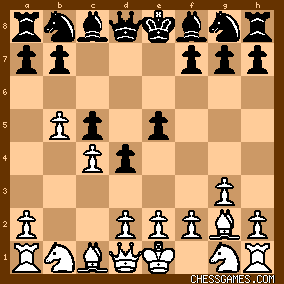
click for larger viewFor what it's worth (and in my opinion it's not worth much), Fritz and Stockfish rate the position as marginally better for White: (0.04 and 0.17 respectively). I like to control the center directly so I would probably opt for Black's game over that of White, but that is a matter of personal taste, I doubt that Keres (assuming he wasn't trying to throw the game) was unhappy about his position at this stage. 6. d3
In his commentary on this game, Keres prefers 6. e3 followed by Ne2 and 0-0. But after 6. e3 Black seems fine and possibly slightly better with 6...Nf6 or 6...Bd6 or even 6...a6. The text looks fine to me. The disparagement of this move seems more a matter of commentators hell-bent to denounce Keres' play. Knowing that Keres got into trouble, were these commentators searching for why Keres lost of analyzing the game objectively? 6... Bd6
Euwe claimed that 6...Be7 was "more accurate," but the text looks fine. After 6...Be7, White looks better with the simple 7. Nf3. 7. e4
Let the trashing of Keres' play begin.
"?"--(Keres)
"Anti-positional" (Golombek)
Keres, Golombek, and Euwe all preferred 7. e3. I tend to agree, but is the text really all that bad. The only coherent criticism comes from Keres, who faults his own move since it blocks the diagonal of his g2 Bishop and does not anticipate a possible f4. Keres' points all are well-taken, but the text was hardly all that bad, even if not the best way to try to tease some advantage out of the position, the position now being: 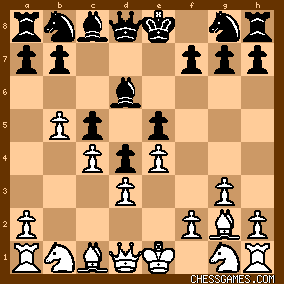
click for larger view7... Qc7
This move by Botvinnik also has come in for criticism. Only Golombek liked the idea of preventing f4--at least temporarily. Keres in his commentary preferred the immediate 7...h5 (the move Botvinnik played on his next turn), but White then seems fine--if not better--with 8. Nf3. 8. Ne2 h5
"!"--(Horowitz)(Keres)
"A move of great cunning. By threatening h4 he induces White to play 9. h4 in return, when g4 becomes weak." (Golombek) "A very original set-up by both players. Black is trying to provoke h4 (by White) after which a later f2-f4 will create a weakness." (Euwe). (see Keres similarly) In fact, amid all the praise of Botvinnik and denunciation of Keres' play, the text (which White did not have to answer with 9. h4) was probably not best. Black would have a small edge with 9...Ne7 or 9...Nd7.. Sometimes, as here, simple development is the right course. After 8...h5, the position was:
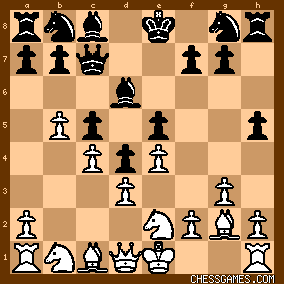
click for larger viewThe only certain thing that can be said about this position is that is was complicated, novel, and pregnant with possibilities for both sides. It is just the sort of position that two players vying for first place in a World Championship Tournament and willing to depart from the beaten track might have reached. |
|
Aug-12-21
 | | KEG: Post III
9. h4
As with practically everything else Keres did in this game, the commentators were divided on the merits of this move, some saying right and others wrong. But everyone managed to condemn Keres: "?"--(Horowitz)
"Practically forced." (Keres)
Keres liked the text, but spoke of the King-side problems Keres faced because of his earlier (i.e. poor) play. Horowitz claimed that 9. f4 was "more consistent with the position." Golombek said that 9. f4 was no improvement on the text in light of 9...Bg4 (actually 9...h4 or 9...Nf6 would be better and would give Black the edge) 10. f5 (correct would be 10. h3). Euwe seconded Golombek's doubtful analysis. In fact, 9. a4 (not mentioned by any of the commentators) is probably best. The text does create some weakness for White on the King-side, but it was hardly a blunder or warranting Horowitz' "?" 9... Nh6
Golombek (falling all over himself to praise Botvinnik when he was not criticizing Keres' play) said this move was "better than 9...Nf6" because of White's reply 10. Bg5 (hardly best for White) overlooking Black's happy choice then of 10...Nh7 or 10...Nbd7. In fact, the text is no improvement on 9...Nf6, and better than either of these choices were 9...a6 and perhaps 9...Bg4. 10. 0-0 Bg4
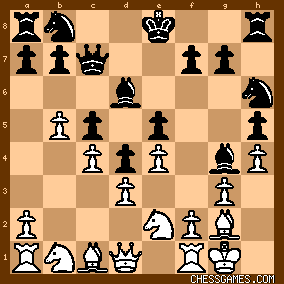
click for larger view11. f3
Keres was unsparing in his criticism of this move, which he said: "...closes the diagonal for his b2-Bishop even more. At the same time it weakens the e3-point..." He concluded that 11. Nd2 was best. Yet again, the perceived need to trash Keres' play led to an exaggeration. The text is not a great way to play for a win, but it sets up a fortress that is hard to breach. 11. Nd2 is slow, and Black can obtain some advantage with 11...a6 striking at White's Queen-side. Perhaps best for White is a move none of the commentators mentioned: 11. a4 (perhaps followed by 12. f3 if Black plays 11...a6). 11... Be6

click for larger view12. f4
Time to get back to Keres-bashing.
"?"--(Golombek)
"Once more he chooses the wrong plan."
Meanwhile, Keres said that f4 has to be played "sooner or later." Keres went on, however, to note the analysis by Romanovsky, who preferred 12. a4 which looks good to me. 12... Bg4
"The pin created by [this move] is a bit awkward for White." (Keres) 13. f5
"?"--(Golombek)
"White's play grows weaker as his difficulties increase..." "Now Black has a break in reserve on the King-side, when and if he is ready." (Horowitz) "It is...not easy to agree with this advance...By closing the position, White deprives himself of the chance to achieve an attack or ever take control of the once important d5-point." (Keres) With all the denunciations of Keres' play to this point, one might imagine that he was busted. In fact, the position was not all that awful for him: 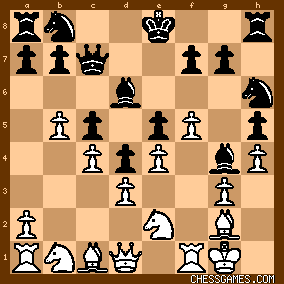
click for larger viewThe alternatives suggested to 13. f5 were no great shakes. Golombek gave the hardly dynamic 13. Qe1 as best, but Black can then just calmly develop with 13...Nd7 or play on the Queen-side with 13...a6. Keres had a more interesting idea: 13. fxe5 Bxe5 14. Bf4 Nd7 15. Nd2 (15. Qd2 or 15. Qe1 look better, but even then Black is better after 15...BxN 16. QxB Ng4) , but now Black gets a major advantage with 15...BxB 16. gxB (16. RxB Ne5 is even worse for White) a6 (or even 16...Nf8) Once again, Keres' play was at least reasonable if not best. 13... Nd7
14. Nd2
14. a4 was arguably better, but the text did not leave Keres all that badly placed: 
click for larger viewThe real problem for Keres at this point was that he--like Botvinnik--was taking a lot of time given the novel piece alignment and was beginning to flirt with time trouble. |
|
Aug-12-21
 | | KEG: Post IV
Suddenly the commentators noticed that Keres' last move (14. Nd2) contained more than a drop of poison. His plan of course was Nf3 and then either Nh2 or Ng5. Botvinnik, alert to Keres' idea, played: 14... g6
The commentators, needless to say, went into raptures over this move: "!"--(Golombek)
"Played at just the right moment..." (Golombek)
"To forestall Nf3-h2..." (Horowitz)
Keres went further and called Botvinnik's move "necessary." But the text allows Keres' f1 Rook to come into action and does not seem to lead to more than approximate equality. If there is a way for Black to play for some edge, 14...a6 or 14...0-0 (followed by 15...a6) look like the best tries. 15. fxg6 fxg6
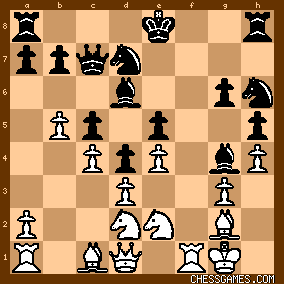
click for larger viewAfter all the praises heaped on Botvinnik's play and all the abuse thrown at Keres' play, is Black all that much better here. The best assessment was that of Euwe who said that Black is now "slightly better," opining that Black's weakness on g5 is more than counterbalanced by White's weaknesses on g4 and e3. In reality, the game at this point was very much up for grabs. I would expect the better player to win here with either White or Black. More important was the clock: Keres: 1:12
Botvinnik: 1:22
16. Nf3 Be7
16...Nf7 looks somewhat better.
17. Rf2
Keres said this was best, but over-protecting the e2 Knight was hardly critical. 17. a4 was still a lively possibility and probably best. Keres could also have stabilized his position with 17. Bd2. 17... Qd6
Keres described this as a "waiting move" by Botvinnik"...hoping for a mistake from his opponent." He concluded that 17...Nf7 preparing for g5 was better. That is likely true, but best of all for Black was probably 17...a6 For whatever reason, the players and the commentators all seem to ignore the possibility of action on the Queen-side. After 17...Qb6, the position was:
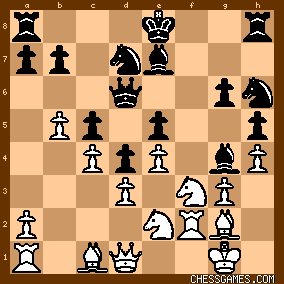
click for larger view18. BxN
The commentators were virtually unanimous about the defects of this move: "?"--(Golombek)(Keres)(Wade-Whitely--Keene)
"...loses further ground." (Golombek)
"This..aggravates the weakness at e3..." (Horowitz) "This exchange did not even come into consideration here, because subsequently White cannot use the open f-file in order to penetrate...Now the c1--h6 diagonal is weakened decisively and especially the e3-point is a positional weakness." (Keres) A strange comment from the fellow who actually played 18. BxN here. Interestingly enough, Stockfish gives 18. BxN as best. The idea of preventing the Knight to come to f7 to support g5 looks more than reasonable to us non-silicone observers. Keres at least had the humility to say that finding a superior alternative was "Not so easy." Let's have a look at the suggested alternatives: Golombek suggested 18. Bd2 (not exactly a dynamic choice). Keres said that this would be part of a "waiting game" with the intention of either doubling Rooks on the f-file or playing Qc1 followed by Ng5. The line given by Golombek after 18. Bd2 does not look very promising for White: 18. Bd2 0-0-0 (18...a6 or 18...Nf7 look better and seem to give Black a decent edge) 19. Qc2 (this seems pointless, 19. a4 was much better than Golombek's move) Rdf8 (Black could instead have played BxN and gotten much the better game). Even here, Black seems slightly better. Horowitz suggested 18. Nh2, but now Black can proceed with his plan to support g5 by playing 18...Nf7 with much the better chances. Keres also suggested 18. Ng5, but then Black would be better with 18...0-0-0. In sum, Keres' 18. BxN was hardly a mistake and left him at least as well off as he would have been with any of the suggested alternatives. If there was a superior alternative to 18. BxN, it was probably 18. a4, a Queen-side venture not considered by any of the commentators. 18... RxN
19. Qd2 Rh8

click for larger viewFor all Keres' supposed transgressions, his position at this stage was not an eyesore. Stockfish's assessment is 0.00 Fritz gives Black a small edge (-0.28) |
|
Aug-12-21
 | | perfidious: <KEG>, I should note en passant that one positive side of computers is that annotation by result, part and parcel of game commentary into the 1980s, has largely ceased to exist as an art form, inasmuch as those silicon monsters ruthlessly bare nearly every imprecision. |
|
Aug-12-21
 | | plang: Personally, I don't see that as a positive. I will always prefer GM annotations (perhaps assisted by a machine) preferably with detailed explanations in addition to analysis. I am most interested in how GMs think - computers are useless in that regard. |
|
| Aug-12-21 | | Olavi: Often a seasoned player is needed for an assessment of how real the chances are. Looking at the last diagram, with white's useless bishop and badly restricted knights, it is obvious that only black has any hope of even thinking of playing for a win. |
|
Aug-12-21
 | | perfidious: <plang>, make no mistake: by no means am I a fan overall of many of the changes which have taken place since software entered the fray. My quarrel with what I referred to as 'annotation by result' is what Nunn once wrote of as the oft-seen tendency to comment on a game as though the victor had done everything right, while his hapless opponent could not get out of his own way. As <Olavi> notes, while silicon may view the position in the last diagram posted as only marginally inferior for White, an experienced player will realise at once that Botvinnik had whatever chances there were. |
|
Aug-12-21
 | | keypusher: <plang: Personally, I don't see that as a positive. I will always prefer GM annotations (perhaps assisted by a machine) preferably with detailed explanations in addition to analysis. I am most interested in how GMs think - computers are useless in that regard.> Engines are so strong now that I don't think a responsible annotator can avoid using them. Of course you're right that nothing is more useless than lines without discussion. A good example of the intelligent use of a computer by a very strong GM is Wesley So's notes to Carlsen's sole classical win in the Karjakin match Fischer vs Petrosian, 1971 (kibitz #373). <KEG> I am enjoying your notes, as always, and look forward to more. I do think you're giving Keres too much slack -- certainly more than he gave himself. (I think we may be using different engines as well -- my SF14 on my desktop is -0.37 at 39 ply after 19...Rh8.) Given the kind of position this is, you're not going to see -5.0 computer evaluations in the early going, and you're certainly not going to see perfect play from either side. And I'm sure the human annotators you're quoting are overstating their case -- Golombek in particular, it sounds like. But it's hard for me not to be strongly critical of Keres' play (setting aside the possibility that he feels obligated not to play his best). Consider the circumstances, which you already summarized. It's the end of the first of five cycles. Botvinnik is a half-point in front of Keres. And Keres has a bit of good luck -- he gets three whites and two blacks against the tournament favorite. Here's his first White. This is a game where Keres needs to seize opportunity by the forelock! And what does he do? He plays a flank opening, ceding space in the center, fianchettoes his bishop, then blocks its diagonal. With a kind of reversed King's Indian, he then plays f2-f4-f5, and after that there's really nothing for him to do except faff around and try to stay out of trouble. This is a critical game for the world championship and he's played the first 20 moves like an arthritic squid. Yeah, he's not losing, but he's sure as hell not winning. |
|
Aug-13-21
 | | KEG: <keypusher>I would not have recommended the strategy Keres employed. But he had never won a game from Botvinnik in eight prior tries, and had every reason to believe that Botvinnik would be prepared to the hilt. So he played an unusual opening which--by the way--no less a player than Wesley So used--successfully--as recently as 2019. Let's put it another way. Imagine that Keres had prevailed using this opening, as So recently did. Would anyone be condemning Keres then? Was So trying to throw the game he won in 2019? As I'm sure you know (and as I am sure Keres knew), Reti at New York 1924 played a flank opening against the mighty Capablanca and scored a famous upset (though not just because of the opening). I know from my own play when taking on an opponent who had thrashed me in the past that trying something outlandish (e.g., the Stafford Gambit or the Wing Gambit) sometimes is a way to try to turn the tables. Sometimes this sort of nonsense actually works, even at classical chess. As I played over this game, I had the distinct impression that this was what Keres was trying here. If my mind had not been clouded by all the allegations that Keres was throwing the game, I doubt this would even have crossed my mind in examining this encounter. in fairness to your analysis, I have not yet reached the most questionable of Keres' moves in this game (i.e., moves 25 and 27). But those moves were played in time pressure, and we have all wilted in such circumstances. It is hard to disagree with <Olavi> that Black looks better after 19...Rh8. I also agree with <plang> that computers are of less value than strong grandmaster commentary in evaluating openings and early middle-game play and strategy. But as I have tried to point out both sides had weaknesses as of 19...Rh8. The grandmaster commentary in this game seems hopelessly biased by what <perfidious> aptly calls "annotation by result." As for the position itself after 19...Rh8, would Keres' pieces and arrangement have looked all that silly had he continued 20. Raf1 followed by 21. Ng5? He would certainly have had some counter-play. I agree that Black would still probably be better, but the position would not be the one-sided affair the commentators have claimed it was (and that it became just a few moves after 19...Rh8). Remarkably, not one of the commentators I have seen even suggested 20. Raf1 as a possibility even though that was the first move that crossed my mind. Once again, this smacks of "annotation by result." I'm not going to mount a vigorous defense of Keres play. This game will never appear in any anthology of Keres' best game. I have always admired Paul Keres. He should be at the top of any rational list of the best players never to win the world championship, with perhaps only Tarrasch, Pillsbury, Korchnoi, and Caruana as possible alternatives. His problems against Botvinnik have always bothered me. And playing over this game is painful for us Keres fans. But Keres' problems against Botvinnik didn't first materialize at the 1948 World Championship Tournament. At the 1941 "Absolute" Championship of the USSR, Keres had--as here-- White in his game against Botvinnik in the opening lap. Going into that game, Botvinnik and Keres were tied for first place. Keres played a normal d-pawn opening as White, was confronted by Botvinnik's Nimzo-Indian Defense, and got annihilated in just 22 moved. After Botvinnik's 19th move there, he was completely busted and could have safely resigned. Is it outlandish to think that Keres wanted to try something new against Botvinnik, even if that involved getting a theoretically inferior position? So I am reluctant to condemn Keres for trying something different here when he once again confronted the dreaded Botvinnik with White in the opening lap of a strong tournament. |
|
Aug-13-21
 | | KEG: Post V:
20. Ng5?
Premature. As I noted in my response to <keypusher>, 20. Raf1 was best and would have given Keres decent chances of holding his own. 20... Nf6
"?"--(*Golombek)
"Wasting time." (Euwe)
Golombek and Euwe both preferred 20...Rf8. Golombek's follow-up analysis of 20...Rf8 is too riddled with error to discuss, but that move does appear to be better than the text. Better still, however, was 20...Bf6 followed by 21...Qe7 and 22...0-0-0 with perhaps Bg7 and Rdf8 coming next leaving Black well-placed. Incidentally, after 20...Nf6 the time situation was beginning to look scary: Keres--1:39
Botvinnik--1:44.
The position after 20...Nf6 was:
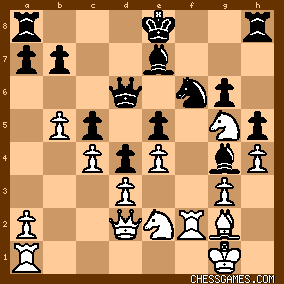
click for larger view21. Re1
Gololbek, Horowitz, and Euwe all liked this move which they say was a way to prepare for Nf4. Though condemned by Horowitz, 21. Raf1 looks better (and is consistent with my earlier idea of 20. Raf1 and then 21. Ng5. Horowitz argued that 21. Raf1 would lead to trouble for White: "Black replies ...Bd7 [21...Rf8 is better and leads to approximately equal chances--KEG] and will anchor his Knight at g4. 22. Bh3 [missing the cute 22. Nf4! exN 23. e5! Qxe5 24. Bxb7 f3! (not 24...Rd8 25. Re2 Qc7 26. Rfe1 and Black is toast) 25. Bxf3 (not 25. BxR Qxg3+ and Black is better) Rb8 26. Re1 Qxg3+ 27. Rg2 Qxh4 28. Qe2 Ne4 29. QxN QxQ 30. BxQ Bg4 31. Bxg6+ and White has excellent winning chances--KEG] BxB 23. NxB Ng4 24. Rf3 [awful analysis--White should play 24. Rf7 with some chances) Ne3 25. R1f2 Qe6 [even better was 25...0-0-0--KEG] and White is in said straits." With best play (i.e., not the line Horowitz gave) White would not be all that bad after 21. Raf1. And perhaps 21. a4 would have been even better for White. The position after 21. Re1 was:
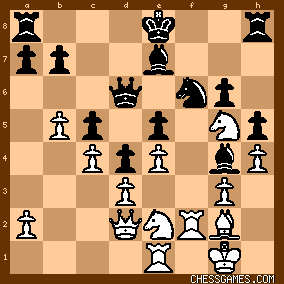
click for larger view21... Qb6
21...Bd7 was probably best.
The position was now:
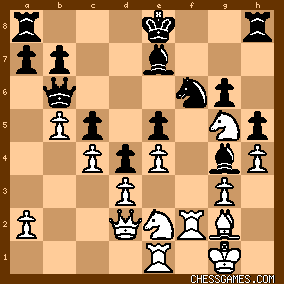
click for larger viewKeres--1:47
Botvinnik--1:53.
22. Nf3
"Hoping to be allowed to play 22. Qg5, but as Black can easily prebent this, it would be better to proceed at once with his Queen-side advance and play 22. a4." (Golombek) "Stronger is 22. a4 with the intention of forcing a5." (Euwe). Agreed.
22... Nd7
"Not only Nxe5 was threatened, but 23. Qg5." (Keres) Stockfish also likes the text. But 22...BxN 23. RxB Ng4 looks strongest for Black. After 22...Nd7 the position was:
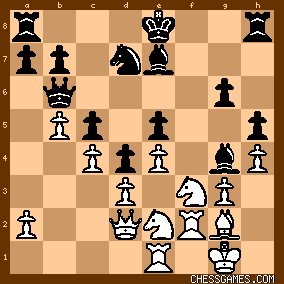
click for larger viewBlack was still better, but White was hardly in critical conditions, and had opportunities for counter-play. The plans he might have pursued include doubling his Rooks on the f-file and clearing their way with Nh2, or playing on the Queen-side with a4. In short, the game was still very much up for grabs. |
|
Aug-13-21
 | | keypusher: <KEG> Well, I continue to enjoy your notes. I'll say for my side that: Keres' three wins against Botvinnik were all games that opened up early, and looked nothing like this one, though I suppose looking ahead is cheating a little bit. I don't think Keres' record against Botvinnik was so bad going into this game that he necessarily needed to change his approach quite so drastically. But I need to be pretty humble when I criticize Paul Keres, of course. |
|
Aug-14-21
 | | KEG: <keypusher>I certainly agree that the strategy Keres adopted in this game proved a miserable failure. It obviously did not suit him, and he wisely switched openings for his next two games as White against Botvinnik in this tournament. My beef is with the over-zealous critique by commentators who decry everything Keres did in this game and/or use it as evidence that he must have been throwing the games. I am not in serious disagreement with most of what you have said here. But I think Keres' strategy, though entirely unsuccessful here, was not irrational. Most of all, I agree with you that we must be humble and cautious when criticizing the great Paul Keres. |
|
Aug-14-21
 | | KEG: Post VI
23. Ng5
Objectively, 23. Ref1, and probably 23. a4, were better choices. Perhaps, however, Golombek was right and this move was a "tacit offer of a draw" by Keres, inviting Botvinnik to repeat moves. If so, Botvinnik was not interested and, as Euwe said, used the opportunity provided by Keres to correct his poor 20th move. 23... Rf8
"!"--(Horowitz)
"There is more to Black's move than meets the eye. His plan soon unfolds." (Horowitz) There is indeed much to be said for 23...Rf8, but a good alternative was 23...a6 addressing the potential crisis brewing on the Queen-side. Also, the text allowed Keres to trade Rooks. The position after 23...Rf8 was:
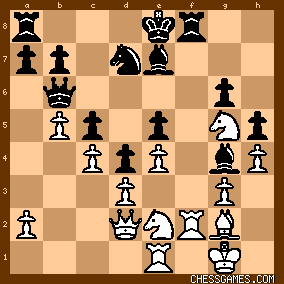
click for larger view24. RxR+
"?"--(Golombek)(Keres)
"Keres embarks on an entirely purposeless maneuvre...He urges the Bishop on to a better diagonal." (Golombek) "In the emerging time-trouble White starts to play very weakly." (Keres) Golombek and Keres recommended 24. Ref1 rather than the text. Golombek gave no follow-up to 24. Ref1. But Keres did, but he only considered 24...0-0-0 which would forfeit pretty much all of Black's edge after 25. Bf3 or 25. Nf7 (both of which are far superior to Keres' suggested 25. Nf3). But after 24. Ref1 Botvinnik would have much the better chances with the simple 24...RxR 25. KxR BxN. Given the above, Keres' 24. RxR+ was probably best play, all the contrary commentaries notwithstanding. 24... BxR
This may or may not be theoretically superior to 24...NxR. But in practice Botvinnik struck gold with this move in light of Keres' disastrous reply. After 24...BxR, the position was:

click for larger view25. a4?
"?"--(Golombek)(Keres)(Wade--Whitely--Keene)
Keres may not have been theoretically lost after this lemon, but the move is execrable in any case. As all the commentators pointed out, Keres should not have allowed Botvinnik to pin the White g5 Knight with Bh6. The simplest solution, though involving some loss of face, was to retreat with 25. Nf3. Alternatively, 25. Bf3 seems to be an improvement, though after 25...Nf6 26. Rf1 BxB 27. RxB Ng4 Black would have a significant edge. After Keres' sloppy 25. a4?, Botvinnik took charge with: 25... Bh6
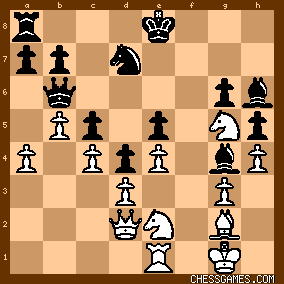
click for larger viewThe pin of the g5 Knight was to be a theme that would haunt Keres until he finally lost material. Even if the game was still savable for White, in my book this was the move that cost Keres the game. 26. a5?
Keres seems as paralyzed as his Knight. He had to play 26. Kh2 or Romanovsky's 26. Kh1. After the text, Botvinnik could simply have played 26...Qd8. But... 26... Qf6?
"!"--(Horowitz)
Horowitz' "!" notwithstanding, this move by Botvinnik was a clear mistake. The better way to gang up on the g5 Knight was with 26...Qd8! Keres could now have been back in the game with 27. Rf1, the position now being: 
click for larger viewHere, however, Keres blundered, perhaps because of time-trouble, and Botvinnik never gave him another chance to save the game. |
|
Aug-14-21
 | | KEG: Post VII
27. Nc1?
I do not understand this move at all.
"What the Knight is to do in the desert spaces of the Queen-side is not quite clear. Instead he should play 27. Rf1..." (Golombek) 27... 0-0-0
"Simpler was 27...Nf8-e6 because White now manages to thwart (initially) this maneuver. But Black is in no hurry, so nothing u pleasant will happen to him as a result of this small inaccuracy." (Keres) I have nothing to add to Keres' comment.
28. Nb3 Rf8
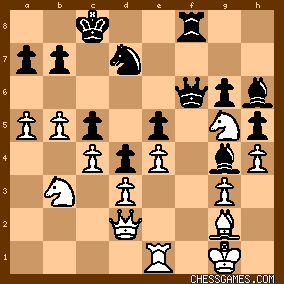
click for larger view29. Ra1
Keres claimed that 29. Rf1 was "much better." But after Keres' suggested 29. Rf1 Qe7 30. Qc1 Black would have things all his own way with 30...RxR+ 31. QxR BxN 32. hxB White's busted King-side will lead to his doom. In the above line, 30. Qc1 looks awful, but even with something better White is lost. 29... Qe7
Keres--2:12
Botvinnik--2:10.
30. Qc1
A desperate attempt by Keres to find a way to unpin his Knight. But after the text, Botvinnik had a clear road to a quick victory. Better chances were offered by 30. Kh2 or 30. b6. Now, after 30. Qc1, the position was: 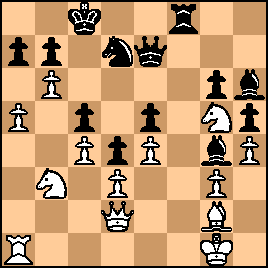
click for larger view30... Kb8
Perhaps because of time-pressure, Botvinnik missed 30...Rf7 followed by Nf8--e6 winning. But, as Horowitz pointed out, Botvinnik was in no hurry (and played Rf7 on his next move) 31. Ra2 Rf7

click for larger view32. Qa3
"The immediate 32. b6 is slightly better..." (Euwe) True. But Keres' comment that the position was now beyond repair is also correct. As will be seen, Keres' plan from here on was to play for tactical tricks. None of this worked against Botvinnik, but it shows how difficult winning even a clearly won game against a creative grandmaster can be. 32... BxN
33. hxB Bd1!
"!"--(Horowitz)(Keres)
"White's g-pawn is doomed." (Horowitz)
All of the commentators made similar comments, the position now being 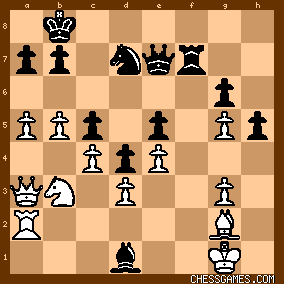
click for larger viewWith Botvinnik poised play 34...BxN and then 35...Qxg5, the game looked over. But as will be seen, Keres still had a few tricks up his sleeve. |
|
Aug-14-21
 | | keypusher: <Now after 30.Qc1, the position was> I think the diagram shows White playing 30.b6 rather than 30.Qc1. |
|
Aug-14-21
 | | KEG: <keypusher>Oops! You're right. Thanks for catching this. And thank you for reading this so closely. |
|
Aug-14-21
 | | KEG: Post VIII
34. Qc1
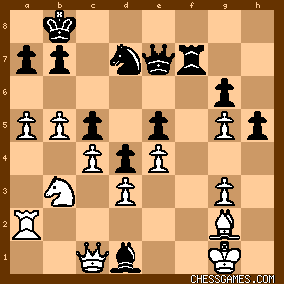
click for larger viewSetting a trap that might snare a player in time trouble. "A bit of by-play. Technically the game is over." (Horowitz) "A little joke." (Euwe)
34... BxN
35. Rb2
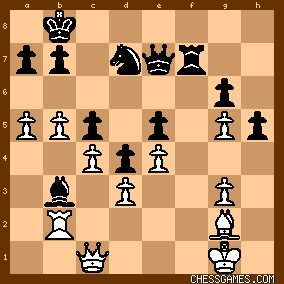
click for larger viewHad Botvinnik here reflexively played 35...Bxc4?, Keres would suddenly be back in the game after 36. QxB with..to quote Keres..."good counterplay." Keres also lists 35...Ba4 as a mistake, noting that after 36. Ra2 Bxb5 37. cxB White would get counterplay on the c4...g8 diagonal. But Black still seems to be winning in that line, and in any case after 36. Ra2 could simply play 36...Bd1 as he did in the actual game. Botvinnik, as might be expected, did not fall for any of this and, playing with an iron hand, now that he had the game in hand simply replied: 35... Bd1
"!"--(Horowitz).
This seemingly finishes off Black. But Keres somehow managed to keeo the game interesting for quite a while. Keres notes that Botvinnik could also have won with 35...Rf8 36. RxB Ne6. A cute line! 36. QxB Qxg5

click for larger view"At last." (Horowitz)
37. Qe1!
Anything else gets crushed immediately.
37... Nf8
37...Nf6 was more accurate, but the text is good enough. 38. Kh2?
A bit of sloppiness by Keres, who was in serious time-pressure. 38. Kh1! was correct. The difference between 38. Kh2 and 38. Kh1 would have become manifest had Botvinnik responded 38...h4, as I will discuss below. 38... Qf6
Botvinnik (who was also in time trouble) could have punished Keres' last move by 38...h4 and if now 39. gxh4 (which would have provided some respite had Keres played 38. Kh1) Rh7! 40. Bf1 Rxh4+ and now the Rook cannot block with Kh2 as it could have done had Keres played 38. Kh1. But, needless to say, this sort of analysis is grossly unfair to apply to over-the-board play in a crucial game. Botvinnik's move was good enough to preserve the win. No small accomplishment when confronted with nasty traps from Keres in a time-pressure scramble. 39. Bh3
39. b6 looks like a better try (though almost certainly still hopeless). But--once again--Keres' time pressure must be recalled. 39... Nh7
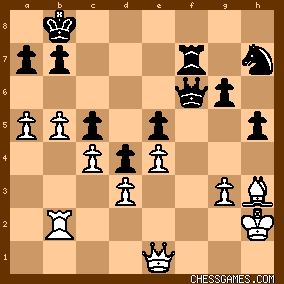
click for larger view"White now can do very little to avert the inevitable end, since he is not only a Pawn down but has much the worse position on the King's side, which is the only wing where action can take place." (Golombek) I will not quibble with Golombek's general assessment. But--if White has any practical chances here--they lay in trying to create action on the Queen's side. In fact, and as will be seen, Keres tried to find ways to make trouble on both sides of the board. But given that the opponent was Botvinnik and given that the move 40 time control had nearly been reached, prospects of saving the game were small. |
|
Aug-14-21
 | | KEG: Post IX
40. Qd1
"Slightly better was to play 40. b6 a6 and only then 41. Qd1 when White would have prevented the possibilities that occurred in the game. But of course Black should win in any case with his extra pawn." (Keres) 40. b6 (see also Euwe) would have been an interesting try, but 40...Ng5 would be a powerful and much better than Keres' suggested 40...a6. And if Black did play 40...a6 then 41. Qd1 would hardly have been best (maybe 41. Bg2 instead) and would run into trouble if Black played 41...Ng5. Perhaps 40. Bg2 (or maybe 40. Ra2) was best, though 40...Ng5 would still have been very strong for Black. 40... Ng5!

click for larger view41. b6
The sealed move. As Golombek noted, this move has the practical merit of setting up a number of possible traps. Objectively, 41. Bg2 was probably best, but--as Golombek went on to say--"one way of losing is as good as another." The text at least creates some complications. The position after 41...b6 was:
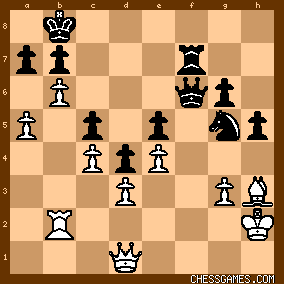
click for larger viewInterestingly, only here does Kasparov begins his commentary on this game in "My Great Predecessors." 41... h4
"!"--Horowitz)(Keres)(Wade--Whiteley--Keene)(Kasparov-
) The commentators debated whether 41...a6 would also have. Golombek and Euwe say that White would then get some chances with 42. Bg2, Golombek going on to say that White would continue from there with 43. Qa4 and have "mating possibilities." But Black would doubtless then play 42...h4 and then after 43. Qxa4 hxg3+ 44. Kg1 Qh8 White would be the one getting mated. Keres correctly stated that 41...a6 also wins, but only considers the disastrous response 42. Qa4 which gets killed after 42...Rf8. After 41...h4, the position was:

click for larger view42. Qg4
"!"--(Kasparov)
"This looks better than it really is." (Euwe)
42. Qg4 was the only even practical chance.
42... hxg3+
43. Kxg3
Of course not 43. Qxg3? Rh7, as pointed out by Kasparov. After 43. Kxg3, the position was:
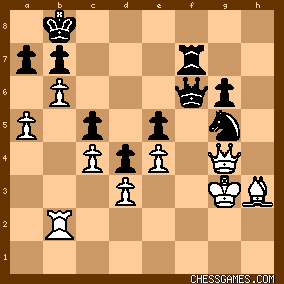
click for larger view |
|
Aug-14-21
 | | KEG: Post X
43... Rf8
"?"--(Keres)
"An inaccuracy that again yields White genuine defensive chances." Keres, as will be seen, was mistaken in this regard. He erroneously believed White could and should have replied 44. Bg2. I will discuss this possibility and the basis for Keres' incorrect assessment of it below. The text in fact wins, as I will attempt to show, though Horowitz' claims that "Now it is all over" was a bit of an overstatement given the complications still to come. There was, however,a debate amongst the commentators as to whether Black could also have won here with 43...NxB. Keres stated that 43...NxB "would have won on the spot." Golombek said that 43...NxB would have won "easily enough." By contrast, Kasparov claimed that 43...NxB would lead to a draw. In fact, 43...NxB wins, but it would take some work: 44. QxN (not 44. KxN Qf1+ as pointed out by Keres) Qf4+ 45. Kg2 and now 45...g5! (Keres' move) and not Kasparov's 45...Qf1+? which probably allows White to save the day) 46. Qh6. Kasparov claimed that Black could not win after 46. Qh6, but that turns out to be wrong: 46...Ka8! (a neat problem move) 47. a6 Qf1+ 48. Kh2 Rf2+ 49. RxR QxR+ 50. Kh3 Qf3+ 51. Kh2 Qf4+ 52. Kg2 Qg4+ 53. Kh2 Qh4+ 54. QxQ gxQ 55. axb7+ Kxb7 56. bxa7 Kxa7 and Black can win the King and Pawn (soon to be Queen) ending: 57. Kh3 Kb6 58. Kxh4 Ka5 59. Kg4 Kb4 60. Kf5 Kc3 61. Kxe5 Kxd3 62. Kf5 Kxc4 63. e5 d3 64. e6 d2 65. e7 d1(Q) 66. e8(Q) Qf3+ with a still difficult winning process ahead. In sum, 43...NxB would have won, but it would not have been "easy." So Botvinnik's actual 43...Rf8 (which Kasparov reports was given to Botvinnik during adjournment by Flohr) was best. The position after 43...Rf8 was:

click for larger view44. bxa7+
"?"--(Keres)
"Keres is setting a little trap since the solid 44. Bg2 hopelessly loses." (Euwe) Keres thought that 44. Bg2 might have given him a chance to save the game. Golombek, Euwe, and Kasparov disagreed. In this case, Keres was mistaken. Let's consider the position after 44. Bg2 Ne6.
A) Golombek only considered 45. bxa7+, but this clearly loses after 45...Kxa7. Golombek here gives the awful 46. Bf3 (the best chance was 46. a6?!, though this ultimately fails also) Nf4! 47. Rd2 (another poor suggestion by Golombek, though the "better" 47. Rb6 or 47. Rb3 were also hopeless) Rh8 48. Bg2? (almost anything was better than this Golombek suggestion, but by this point it hardly mattered) Rh5 and White can safely resign. B) 45. Bh3? This suggestion by Kasparov is also hopeless in light of 45...Nf4! 46. Qd7? (46. bxa7 was probably better, but also completely losing) Ne2+ 47. RxN Qf3+ 48. Kh2 QxR+ 49. Kg1 Qf2+ 50. Kh1 Qf3+ 51. Kh2 Rh8 and wins. C) 45. Kh2! This move, analyzed by Keres and Euwe, is the best chance. But it fails: 45...Qf4+ (45...Rh8+ and 45. Nf4 also win, but I will follow the analysis of Euwe and Keres here) 46. QxQ NxQ and Black, with his extra (passed) pawn and better placed Rook and minor piece should win. Now let's get back to the actual game.
44... Kxa7

click for larger view45. a6?!
Kasparov correctly points out that there would be no perpetul after 45...Rxb7+ KxR 46. Qd7+ Kb8 47. Qb5+ Ka8 . The most solid move at White's disposal here was 45. Bg2. But after 45...Ne6, White could at most have delayed but not avoided loss. After 45. a6, the position was:
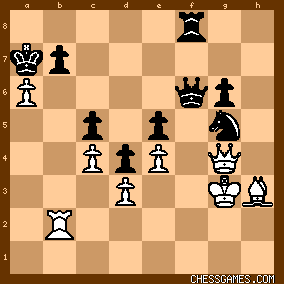
click for larger view |
|
Aug-15-21
 | | KEG: Post XI
45... NxB
Avoiding the little trap: 45...bxa6?? 46. Qd7+ and mate next move. "...after the text-move, White may as well resign." (Keres) Euwe and Keres claimed that White could force a draw after 45...Kxa6. Golombek said that move still wins but that it would have been "riskier than the text." In fact, 45...Kxa6 still wins, though it must have look scary over the board: 46. Ra2+ Kb6 47. Rb2+ Ka5 (not Keres' and Euwe's 47...Ka7? which allows White to draw with 48. Rxb7+ after which there is an inescapable perpetual; and certainly not 47...Kc7??? 48. Qd7+ and mate next move) 48. Ra2+ (Golombek's move, 48. Bg2 is theoretically better but still hopeless) Kb4 49. Rb2+ (once again Bg2 is somewhat better, but entirely hopeless) Kc3 and wins. The position after 45...NxB was:

click for larger view46. QxN
46. KxN? Qf1+ is a fast way for White to lose. And, as Keres pointed out, 46. Rxb7+ Kxa6 gets White nowhere. 46... Qf4+
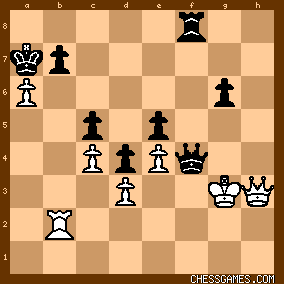
click for larger view"!"--(Horowitz)
"Combining to swap Queens and Rooks." (Horowitz) "Now Black gives a series of checks to force the win." (Euwe) Black could also have won with 46...Kxa6 47. Ra2+ Kb6 48. Qh4 Qf3+ 49. Kh2 Qxd3 50. Rb2+ Ka7 51. Rxb7+ (desperate but hopeless) KxR 52. Qe7+ Kb6 53. QxR Qxc4 with a clear won Queen and pawn ending in which Black has three extra pawns. 47. Kg2 Qf1+
48. Kh2 Rf2+
49. RxR QxR+
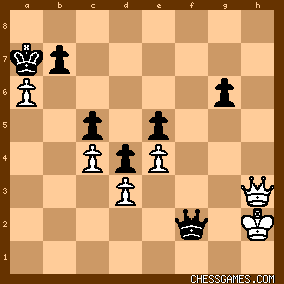
click for larger view50. Kh1 Qe1+
51. Kg2 Qe2+
52. Kg1
52. Kh1 Qh5 leads to a pawn ending that is equally hopeless for White, as all the comentators have noted. 52... Qe3+
53. QxQ dxQ

click for larger view54. axb7 Kxb7
55. Kg2 Kb6
56. Kf3 Ka5
57. Kxe3 Kb4
58. Kd2

click for larger view"A final trap; if 58...Kb3 59. d4 Kxc4 60 dxe5 (60. dxc5 is no better--KEG) with a pawn ending still needing care." (Golombek) Actually, not much care would be required in Golombek's variation since 60...Kb5 spells fini. This all, however, proved moot since: 58... g5
"Botvinnik merely shrugged his shoulders, smiled a little grimly, and played 58...g5." (Golombek) 0-1
"The outside passed pawn decides." (Kasparov) |
|
 |
 |
|
< Earlier Kibitzing · PAGE 23 OF 24 ·
Later Kibitzing> |
|
|
|





































